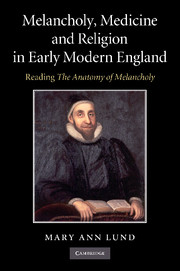Book contents
- Frontmatter
- Contents
- Acknowledgements
- Abbreviations
- A Note on Citation
- Introduction: Zisca's Drum: Reading and Cure
- Chapter 1 Imagining Readings
- Chapter 2 The Cure of Despair: Reading the End of The Anatomy of Melancholy
- Chapter 3 Printed Therapeutics: The Anatomy of Melancholy and Early Modern Medical Writing
- Chapter 4 The Whole Physician
- Chapter 5 Speaking out of Experience
- Chapter 6 The Structure of Melancholy: From Cause to Cure
- Conclusion
- Bibliography
- Index
Introduction: Zisca's Drum: Reading and Cure
Published online by Cambridge University Press: 23 February 2010
- Frontmatter
- Contents
- Acknowledgements
- Abbreviations
- A Note on Citation
- Introduction: Zisca's Drum: Reading and Cure
- Chapter 1 Imagining Readings
- Chapter 2 The Cure of Despair: Reading the End of The Anatomy of Melancholy
- Chapter 3 Printed Therapeutics: The Anatomy of Melancholy and Early Modern Medical Writing
- Chapter 4 The Whole Physician
- Chapter 5 Speaking out of Experience
- Chapter 6 The Structure of Melancholy: From Cause to Cure
- Conclusion
- Bibliography
- Index
Summary
And as that great captaine Zisca would have a drumme made of his skinne when he was dead, because he thought the very noise of it would put his enimies to flight, I doubt not, but that these following lines, when they shall be recited, or hereafter read, will drive away Melancholy (though I be gone) as much as Zisca's drumme could terrify his foes.
(I, 24)In the preface to The Anatomy of Melancholy, Robert Burton imagines his text as a tool to combat melancholy in fearsome fashion. Like the drum of Zisca (Jan Žižka), the famous fourteenth-century Hussite military commander, his ‘lines’ take on power when they are activated, by being spoken aloud or read silently. Burton probably found the example of Zisca in John Florio's translation of Michel de Montaigne's Essays (1603), among a collection of stories about leaders whose bodies were used as talismans in battle, and his choice of this story creates an apt parallel with the act of writing. The skin stretched across the drum recalls the animal hides tightened across frames to make parchment for manuscripts. The comparison points to the status of the written word as a material object. Zisca took literally the idea that his presence would confound his enemies, wishing to make himself into an object that would retain the power he had when living. Even in his absence, he thought, the drum would continue to embody him, broadcasting his fierce reputation to his foes.
- Type
- Chapter
- Information
- Melancholy, Medicine and Religion in Early Modern EnglandReading 'The Anatomy of Melancholy', pp. 1 - 23Publisher: Cambridge University PressPrint publication year: 2010



